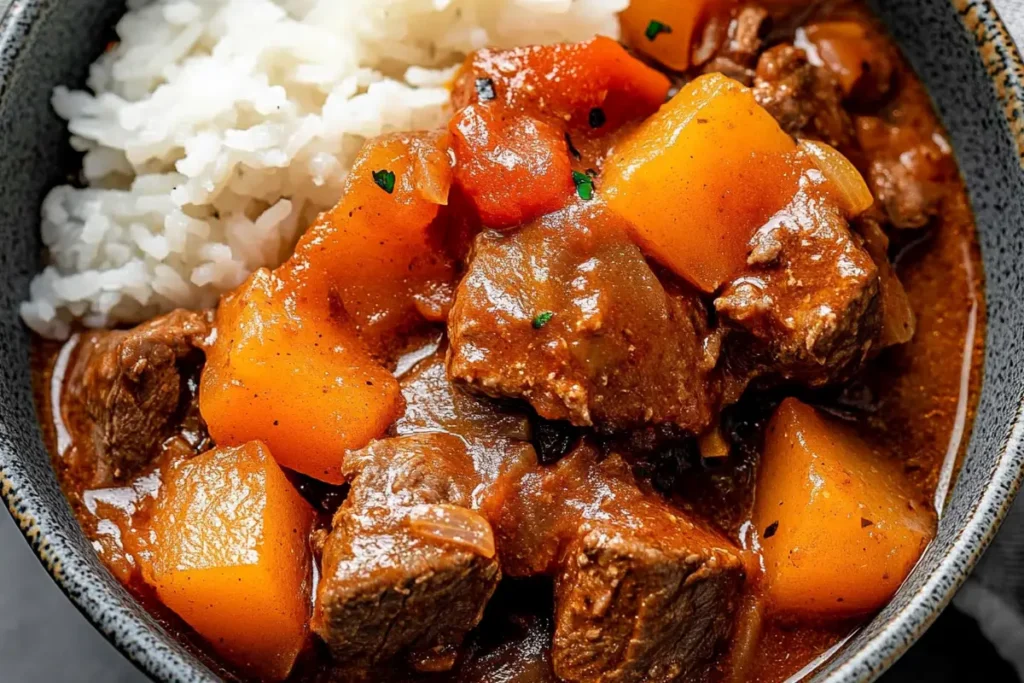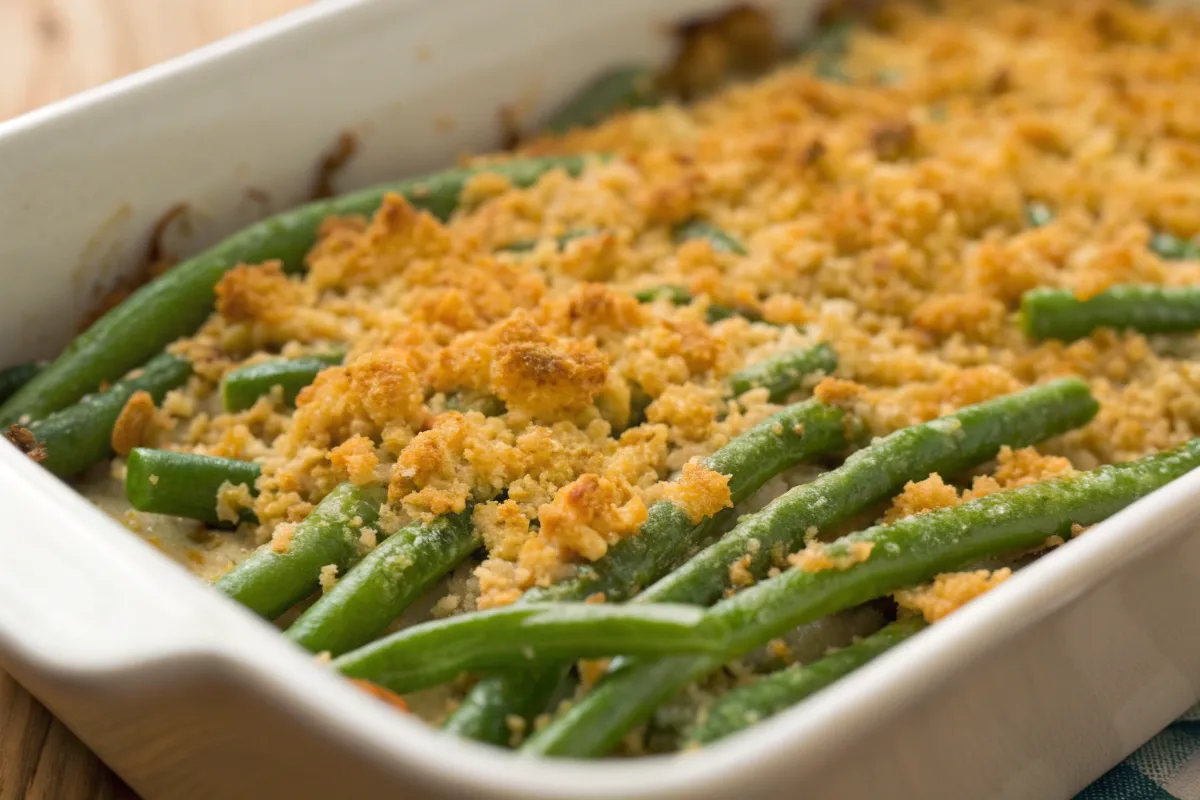There’s something irresistibly cozy about a warm bowl of Hawaiian beef stew, especially when it’s brimming with tender beef, sweet tomatoes, and hearty vegetables. This Hawaiian beef stew recipe brings a beloved island classic to your kitchen with all the comforting vibes you crave in a one-pot meal.
Perfect for chilly nights, rainy days, or when you just need a taste of home, this dish stands out from your average beef stew thanks to its rich tomato base, subtle sweetness, and the soul-soothing flavors that reflect the spirit of aloha. Unlike traditional stews, Hawaiian-style beef stew balances the savory with just the right touch of island sweetness, making it totally crave-worthy.
Whether you’re feeding a crowd or meal prepping for the week, this recipe is as versatile as it is delicious. Once you try it, you’ll see why it’s a staple in local Hawaiian households.
Table of contents
Recipe Card
Pro Tips for Success
Mastering Hawaiian beef stew is all about the right ingredients, patience, and a few smart tricks. Here’s how to make yours truly unforgettable:
- Use chuck roast over pre-cut stew meat if possible. It has better marbling and more flavor when slow-cooked.
- Brown the beef in batches. Overcrowding causes the meat to steam, not sear, and seared beef = big flavor.
- Caramelize the tomato paste. Let it cook for a few minutes before adding liquid. It deepens the sauce and reduces acidity.
- Simmer low and slow. A gentle simmer ensures the beef turns tender without drying out.
- Prep ahead. Chop all veggies before you start cooking to keep things smooth and stress-free.
- Taste as you go. Hawaiian stews are all about balance, adjust sugar or salt to get that perfect harmony of savory and sweet.
- Make it a day early. The flavors meld beautifully overnight and taste even better the next day.
Hawaiian Beef Stew Recipe Serving Suggestions

A bowl of Hawaiian beef stew is comforting all on its own, but pairing it with the right sides makes the meal even better. Here’s how to serve it island-style:
- Steamed white rice is the most traditional and beloved pairing. The rice soaks up the flavorful tomato gravy like a sponge.
- Hawaiian sweet rolls are perfect for dipping, soft, slightly sweet, and buttery. They’re a local favorite for a reason.
- Serve alongside a macaroni salad for a classic Hawaiian plate lunch feel. The creamy pasta salad balances the warm stew beautifully.
- Add a side of pickled vegetables (like kimchi or namasu) for brightness and acidity to cut through the richness.
- Garnish with chopped parsley or green onions for color and a bit of fresh flavor.
- For a casual family meal, serve it in a deep bowl with both rice and stew combined, just like it’s done at many Hawaiian potlucks.
Variants of the Hawaiian Beef Stew Recipe
Hawaiian beef stew is wonderfully adaptable, and there are several ways to tweak it to suit your taste while keeping its comforting island soul intact. Here are some popular and creative variations:
Spicy Hawaiian Beef Stew
If you enjoy a little heat in your meals, you can easily spice this dish up. Add a finely chopped jalapeño or a pinch of crushed red pepper flakes when sautéing the onions and garlic. For an even more authentic local kick, stir in a splash of Hawaiian chili pepper water just before serving.
Pineapple Infused Hawaiian Stew
To bring in more of that sweet-and-savory island flavor, add about half a cup of pineapple chunks, either fresh or canned (well drained), during the final ten minutes of cooking. The sweetness and acidity from the pineapple perfectly balance the hearty beef and tomato-rich broth.
Hawaiian Beef Stew with Coconut Milk
If you’re craving something creamier, replace one cup of water with one cup of full-fat coconut milk. This transforms the stew into a silky, slightly sweet version that still holds all the comforting essence of the original.
Vegetarian Island Stew
For a meatless twist that still satisfies, swap the beef for firm tofu or a plant-based meat substitute. Use vegetable broth in place of water and amp up the root vegetables by adding chunks of sweet potatoes, squash, or taro. This version stays hearty and deeply flavorful without the meat.
Local-Style Flavor Boost
To deepen the stew’s umami profile and bring out more of the traditional Hawaiian plate lunch taste, add a tablespoon of oyster sauce or Hawaiian soy sauce. These ingredients create a more complex flavor that mirrors the kind of stew you’d find at a local island diner.
FAQs About Hawaiian Beef Stew Recipe
Hawaiian beef stew stands out because of its tomato-based broth, slight sweetness, and local-style simplicity. Unlike traditional stews that might rely on wine or stock, this version uses tomato paste and canned tomatoes to create a rich, tangy base. The stew also balances savory and sweet notes, which is a signature in many Hawaiian comfort foods.
Yes, absolutely. To adapt the recipe for a slow cooker, brown the beef and sauté the onions and garlic first on the stovetop, then transfer everything into the slow cooker. Cook on low for 8 hours or high for 4–5 hours, adding the vegetables during the final 2 hours of cooking to keep them from turning mushy.
Yes, this stew freezes very well. Let it cool completely before transferring to freezer-safe containers. Freeze for up to 3 months. Thaw overnight in the fridge and reheat gently on the stovetop or in the microwave, adding a splash of water if needed to loosen the sauce.
Beef can become tough if it’s not simmered long enough or if it’s cooked at too high a temperature. Low and slow is the key. Let the stew simmer gently for at least an hour before adding vegetables. This breaks down the connective tissue in the beef and makes it tender.
Final Thoughts
This Hawaiian beef stew recipe is everything you want in a comfort dish, hearty, flavorful, and filled with island soul. The rich tomato base, tender beef, and perfect blend of sweet and savory make it a go-to meal for cozy nights or meal prep.
For more slow-cooked comfort, check out our Crock Pot Celery and Carrot Soup, or explore Hawaii’s culinary charm with this classic Loco Moco Recipe. Pair your stew with the iconic Hawaiian Mac Salad for the full island-style experience.
Give it a try, and don’t forget to share your version with us, we’d love to see how your kitchen brings this dish to life.











Leave a Reply